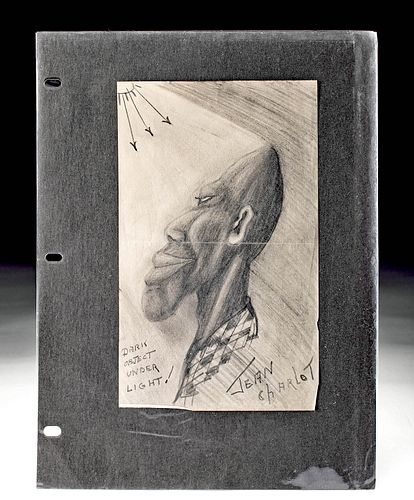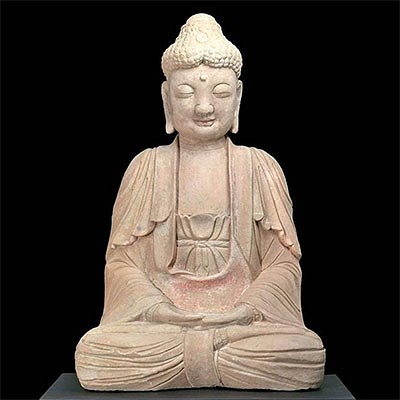Signed Jean Charlot Drawing of Black Man, ca. 1930s
Lot 172
About Seller
Artemis Fine Arts
686 S Taylor Ave, Ste 106
Louisville, CO 80027
United States
Selling antiquities, ancient and ethnographic art online since 1993, Artemis Gallery specializes in Classical Antiquities (Egyptian, Greek, Roman, Near Eastern), Asian, Pre-Columbian, African / Tribal / Oceanographic art. Our extensive inventory includes pottery, stone, metal, wood, glass and textil...Read more
Categories
Estimate:
$1,000 - $1,500
Absentee vs Live bid
Two ways to bid:
- Leave a max absentee bid and the platform will bid on your behalf up to your maximum bid during the live auction.
- Bid live during the auction and your bids will be submitted real-time to the auctioneer.
Bid Increments
| Price | Bid Increment |
|---|---|
| $0 | $25 |
| $300 | $50 |
| $1,000 | $100 |
| $2,000 | $250 |
| $5,000 | $500 |
| $10,000 | $1,000 |
| $20,000 | $2,500 |
| $50,000 | $5,000 |
| $100,000 | $10,000 |
| $200,000 | $20,000 |
About Auction
By Artemis Fine Arts
Feb 18, 2021
Set Reminder
2021-02-18 10:00:00
2021-02-18 10:00:00
America/New_York
Bidsquare
Bidsquare : Exceptional Antiquities, Asian, Ethnographic
https://www.bidsquare.com/auctions/artemis-gallery/exceptional-antiquities-asian-ethnographic-6373
Museum-worthy examples of Egyptian, Greek, Roman, Etruscan, Near Eastern, Far East / Asian, Pre-Columbian, African / Tribal, Oceanic, Native American, Spanish Colonial, Russian, Fossils, Ancient Jewelry, Fine Art, so much more! Artemis Fine Arts info@artemisfinearts.com
Museum-worthy examples of Egyptian, Greek, Roman, Etruscan, Near Eastern, Far East / Asian, Pre-Columbian, African / Tribal, Oceanic, Native American, Spanish Colonial, Russian, Fossils, Ancient Jewelry, Fine Art, so much more! Artemis Fine Arts info@artemisfinearts.com
- Lot Description
Jean Charlot (also Louis Henri Jean Charlot, French-born, naturalized American, active in Mexico, 1898-1979). Untitled pencil drawing on paper, ca. 1930s to 1940s. Signed in pencil at lower right, a fascinating drawing by Jean Charlot of a male of African descent wearing a plaid or gingham shirt, his bust-length portrayal depicted in profile. There is a stylized rendering of a sun at the upper left corner, with rays of light shining over the man's visage, and at the lower left Charlot has written, "DARK OBJECT UNDER LIGHT!" An intriguing composition that features Charlot's signature style favoring bold forms and a modernist rendering of the human figure as well as reflecting his interest in ethnographic physiognomy which was quite popular among the Mexican Muralists as well as the American muralists during this period. Charlot subscribed to the Mexican pride in indigenismo and faithfully depicted the Maya and other indigenous Mexican peoples. In addition, Charlot depicted individuals of African descent. Size: 8" L x 5" W (20.3 cm x 12.7 cm)
See a lithograph by Charlot of the head of a black man after a figure in Charlot's mural entitled "Cotton Gin" (1941) created for the McDonough Georgia (Atlanta) post office funded by the Federal Art Project (FAP) during the Great Depression era at the Metropolitan Museum of Modern Art (accession number 60.713.59).
Born in Paris to a Russian emigre father and a mother whose family originated in Mexico City, with a grandfather who was French-Indian Mestizo, Charlot moved to Mexico City in 1920 when his mother returned. Joining Diego Rivera and Jose Clemente Orozco, Charlot painted frescoes for the Mexican government during the rise of the Mexican Modernist mural movement. In addition, he was hired as a staff artist for a Carnegie Institute archaeological expedition in the Yucatan. In 1929, Charlot moved to the United States, as was popular with many of the Mexican Modernists, and taught at various institutions: the Art Students League in New York City, the Colorado Springs Fine Art Center, the University of Georgia, and the University of Hawaii.
According to the Rollins Cornell Fine Arts Museum, "Over his long and productive career Jean Charlot had a profound influence on printmaking and mural painting in both Mexico and the United States. He was born in Paris and in 1921 moved to Mexico City after the death of his father—his mother was of mixed French and Aztec ancestry, a fact in which the family took great pride. He arrived at an auspicious time in Mexican history, as the period of unrest and social change surrounding the Mexican Revolution was beginning to wind down. When he arrived, he joined a ferment of artistic and cultural experimentation—known as Mexican modernism—that was answering the urgent question of what it meant to be Mexican. Charlot, who brought with him printmaking knowledge and equipment, as well as examples of modernist prints from France, is often credited with helping to inspire a revolution in printmaking in Mexico.
Charlot joined SOPTE (Sindicato de los Obreros Técnicos, Pintores y Excultores), an artist’s union, and signed on to their 1922 'Declaration of Social, Political, and Aesthetic Principles,' written by David Alfaro Siqueiros, whose large fresco murals are icons of Mexican Modernism. In the Declaration, the artists condemned easel painting as overly aristocratic and intellectual, preferring instead the more direct and accessible mediums of murals and printmaking. Charlot also joined the movement of artists and intellectuals known as Stridentism. Influenced by Italian Futurism, Spanish Ultraism, and Dada, Stridentism celebrated modern technology and artistic forms, rejecting the staid classicism of traditional European art. Unlike the Futurists, however, the Stridentists rejected war and fascism, maintaining their socialist political commitments.
Charlot moved to New York in 1929, spending time there with George C. Miller, the best fine art lithographer in the United States, to whom he was introduced by Jose Clemente Orozco, another of his colleagues in the Mexican modernist movement. In 1949 he went to Honolulu to do a mural commission for the University of Hawai'i. He so enjoyed his time there that he stayed until his death in 1979, executing many of his prints by correspondence with Lynton R. Kistler, a master lithographer based in Los Angeles."
Provenance: ex-private Moore collection, Denver, Colorado, USA, acquired prior to 1990
All items legal to buy/sell under U.S. Statute covering cultural patrimony Code 2600, CHAPTER 14, and are guaranteed to be as described or your money back.
A Certificate of Authenticity will accompany all winning bids.
We ship worldwide and handle all shipping in-house for your convenience.
#162393Fold mark across the midline. Minor creases/folds at lower edge and lower right corner. Minute tear/fold at lower right edge above and not obstructing the signature. Otherwise excellent.Condition
- Shipping Info
-
All shipping is handled in-house for your convenience. Your invoice from Artemis Gallery will include shipping calculation instructions. If in doubt, please inquire BEFORE bidding for estimated shipping costs for individual items.
-
- Buyer's Premium



 EUR
EUR CAD
CAD AUD
AUD GBP
GBP MXN
MXN HKD
HKD CNY
CNY MYR
MYR SEK
SEK SGD
SGD CHF
CHF THB
THB















